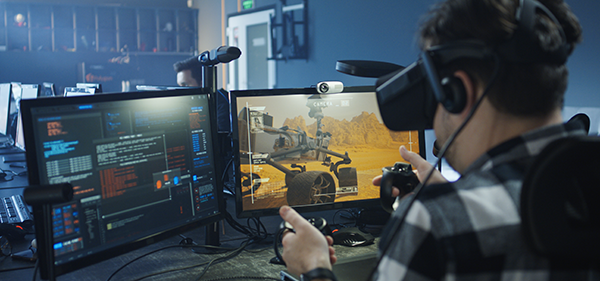
Published June 25, 2024 by John Vondrak
Tags: Manufacturing & 3D Modeling Simulation & Visualization AI, Deep Learning & Machine Learning Data Science
BOXX AI for Your Industry: Development
With the introduction of BOXX AI, and as AI capability and implementation extends across all industries, it’s critical to understand how it directly impacts and provides distinct advantages to your creative business. BOXX has a 28-year history providing hardware solutions to media & entertainment (M&E), manufacturing and product design (MPD) and architecture, engineering & construction (AEC), so we’ll train our focus on those industries. But first, note that we’ll relegate this blog to AI development, i.e., actual AI training and inference computing for model development. To learn about the benefits of AI augmentation (the AI features within each industry’s creative software applications), read the companion blog: “BOXX AI for Your Industry: Augmentation.”
Media & Entertainment
As the cost of creating and distributing content continues to rise and profitability falls, staying competitive requires M&E companies to optimize and accelerate production pipelines. The good news is AI can help operators, creators, and business decision- makers overcome challenges and accelerate all aspects of content production. Generative AI and data analytics have created a wave of possibilities for major studios to improve quality and customer experiences, as well as monetize content in new ways while reducing the overall cost of production and distribution. BOXX AI, powered by NVIDIA RTX 6000 Ada Generation GPUs, is redefining the future of M&E with state-of-the-art AI workstations that accelerate production pipelines and content delivery, provide deeper insights, and optimize distribution and monetization.
 Content Personalization: AI can analyze user preferences and behavior, providing personalized content recommendations for movies, TV shows, games, music, and other media, enhancing user engagement and satisfaction. AI also helps studios dynamically curate and customize content for individual consumers.
Content Personalization: AI can analyze user preferences and behavior, providing personalized content recommendations for movies, TV shows, games, music, and other media, enhancing user engagement and satisfaction. AI also helps studios dynamically curate and customize content for individual consumers.- Predictive Analytics for Audience Insights: AI analytics predict audience behavior to determine marketing strategies, release dates, and content acquisition. To reduce distribution costs, streaming services and live broadcasters can use generative AI and data analytics to monitor and visualize quality of service, predict where/when to preload content, reduce piracy, recommend the lowest-cost content with the highest viewership, and identify cost bottlenecks. Ad content or product placement can also be added at the point of consumption, creating greater relevance for consumers and advertisers.
Manufacturing and Product Design
Product development is becoming more complex as MPD workflows evolve to keep pace with the emergence of new competition, customer expectations, materials, increased regulations, and sustainability initiatives. Manufacturing companies harness the power of AI to enhance various aspects of their operations lifecycle, including product design, engineering, manufacturing, automation, marketing, and sales. BOXX AI workstations, featuring NVIDIA RTX 6000 GPUs, accelerate processes to reach novel solutions.
- Digital Engineering: Generative AI can be trained on legacy product designs and manufacturing information, along with contemporary scientific literature, providing quick and valuable R&D insights. By analyzing data (text, image, and CAD), generative AI can make suggestions to help broaden design space and quickly reach solutions. It can also identify patterns and trends to inform design optimizations. At the end of the product development cycle, AI can be used to generate patents and internal documents, saving valuable time and resources.
- Smart Factories: Manufacturers are embracing generative AI and tools to optimize factory layouts prior to production. With the ability to include video and 3D data in design plans, manufacturers can run simulations and optimize for efficiency in advance, eliminating waste and minimizing costly change orders.

Architecture, Engineering, and Construction
As advanced technologies like building information modeling (BIM), virtual reality (VR), and virtual construction become widely adopted, the AEC industry is grappling with the challenges of competitive productivity, collaboration, cost reduction, and sustainability. AI offers the ability to access decades of knowledge, documentation, and process documentation to automate, simplify, and accelerate the implementation of these technologies.
- Construction Management: With budgeting and decision-making, generative AI can help in estimating construction costs for various design options. By evaluating regularly updated construction site images, generative AI can predict scheduling delays, cost overruns, and make recommendations for improvement.
Implementing AI will accelerate workflows, save time and money, and provide valuable insights—but only if you are able to optimize it with a BOXX AI desk side workstation or data center platform. Trust the experts at BOXX and stay ahead of the competition. Consult with one of our performance specialists today via online chat or call 877.877.BOXX.
